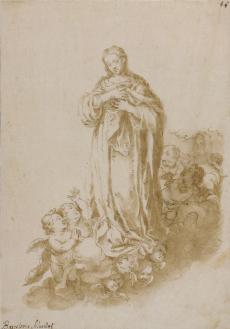


During the past 30 years, the reputation of Bartolomé Esteban Murillo has greatly improved. It is hard to believe that in the 18th century and for much of the 19th, he was rated as the equal of Titian and Velázquez. Murillo’s fall from grace was vertiginous. As Western culture became secularized and as modern art came into being, there was little space for a painter whose fame was based on his excellence as a devotional painter. His paintings are illustrations of Catholic dogma, doctrine and devotion, which were alien to the formation of the modern temperament. The fact that he was indeed a superb painter counted for little. Slowly but surely, he has recovered much of the lost ground. The revival of interest was abetted by the systematic study of his drawings. Despite the fact that Murillo was a dedicated draughtsman, only approximately 125 of his drawings have come to light. More are certain to be discovered. Murillo was versatile, using virtually all the media available at the time. The number of preparatory drawings is a surprise. Murillo was always thought to be a facile painter, almost intuitive in the execution of his works. However, it turns out that a significant percentage of the drawings were made to help him devise his compositions. These drawings follow a pattern, by which the artist concentrated on the principal figure and omitted details of the setting or background.
The drawing in the A. G. Leventis Collection (c. 1660- 1675) is characteristic of this working method. It has long been known that the drawing is related to one of his important late paintings, the Virgin of the Immaculate Conception, in the Nelson-Atkins Museum of Art, Kansas City. The subject was frequently painted by Murillo. Seville, his birthplace, was renowned for its fervent devotion to this cult and actively supported the movement to elevate the Immaculate Conception from a doctrine to a dogma of the Catholic Church. Hence, the demand for paintings of this subject was intense. There are approximately 20 autograph versions by Murillo in existence, none of which, with one or two exceptions, repeats the composition of any of the others. The iconography of this subject does not leave an artist much to work with – the Virgin Mary stands in an indeterminate place amidst the clouds, escorted by putti, some of which hold symbols of her purity. Perhaps this is the reason why Murillo needed to rethink his approach to the subject in this drawing.
Murillo used one of his favourite techniques, pen and brown ink with brown wash. In this drawing, he employed a toned paper, which established a mellow atmosphere. Linear elements certainly predominate. Following his practice, he developed the composition using closely spaced, parallel lines for the shading, occasionally adding short, zigzag passages in darker ink, as can be seen in the drapery folds at the bottom of the mantle. After drawing the figure with pen and ink, Murillo softened the shadows by adding brown wash. Then, he brought the putti to life. Murillo must have rendered more putti than any other painter in the history of European art. Five are included in this drawing, far fewer than appear in the finished painting. However, there are also drawings which consist only of putti flying at high altitude. Other changes between the drawing and the painting are relatively few. Murillo had established the composition and the distribution of light and shadow to his satisfaction. The drawing, which is in excellent condition, is an epitome of the draughtsmanship of this exceptional, original painter of the Baroque
He was the leading painter in Seville in the late 17th century, and his work was widely admired throughout Europe in the 18th century and much of the 19th. Though known mostly for his Counter-Reformation religious paintings, especially of the Immaculate Conception, he also painted lively scenes of women and children engaged in everyday activities. His early works were influenced by Diego Velázquez and Francisco de Zurbarán. His fame rested on his skill in rendering Catholic dogma accessible in paintings that appealed to the faithful.